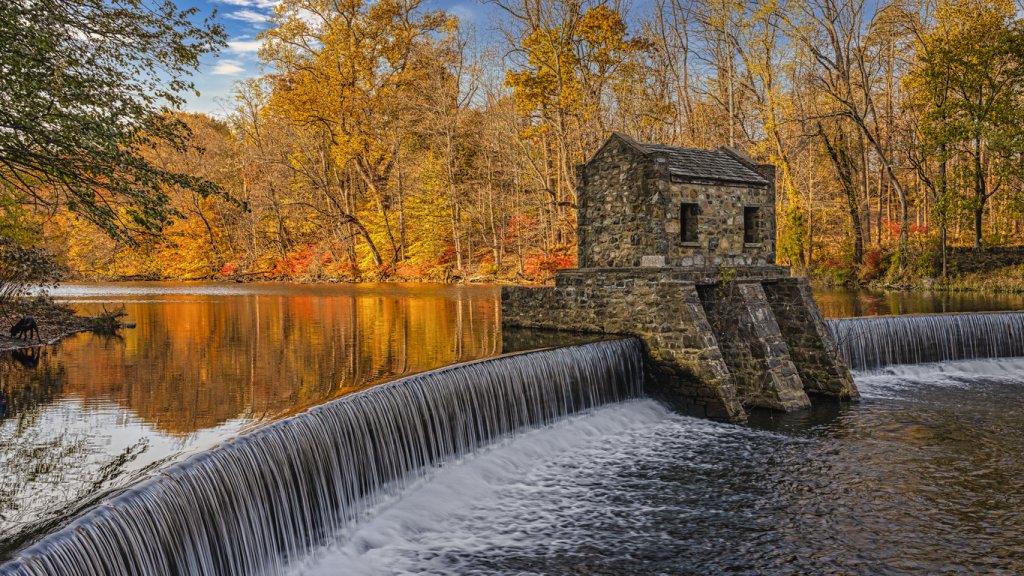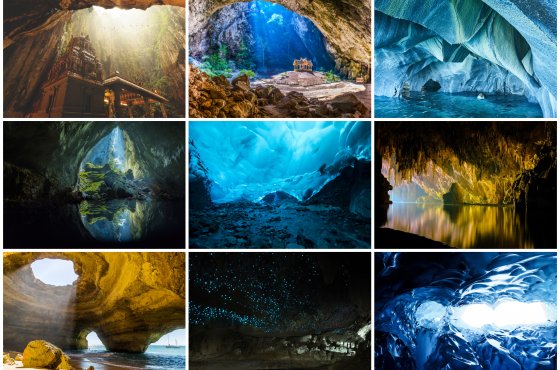Hundreds of Americans are dying because of low dams: why the government does nothing about these 'killing machines'
Hundreds of Americans died from being sucked into the "low" dams used in the late 1800s in mills and distilleries. More than 10 of them were built across the country, and they still remain in place - not very high, which is how they got their name, these dams stretch from coast to coast, but they are difficult to see. Many of them are no longer needed, but they are still capable of dragging swimmers. Edition USA Today talked about these "killing machines".

Photo: IStock
In August, a man drowned in Scott County while rafting with his 17-year-old son near the low Elkhorn Creek dam. This was the second time in 15 months.
At least 37 people died in Kentucky at the site of the dam, and around the country - about 1400 people.
But the true number is unknown because there are no federal or local agencies responsible for inventorying low dams, repairing them, or tracking down dead people.
“Many dams are truly abandoned,” said Manuela Johnson of the Association of Public Officials for Dam Safety. Nobody claims them. But they are still there."
Johnson said the dams are killing people far beyond the US. For example, she estimates that six or seven people die every day in India.
“I have a Google alert set up with two words: dam and drown. I get a report every day,” she said.
Low dams look small and scenic, but they can kill even in seemingly calm waters.
When the water flows through the dam, it enters the river below and begins to create a strong pressure. Everything that is nearby can go under water. This unique current is so deadly that it has been dubbed the "drowning machine".
"It's like giant hands reaching out to you, grabbing you and dragging you to the dam," Dean Peak of Harrison County described the process.
Peak once saved a man trapped in a dam, saw another person die, and was dragged into this "drowning machine" himself, but he managed to escape.
“Once you get close enough to the pressure, it takes you underwater,” he explained.
Re'Jeana Kraft, a member of the Harrison County Search and Rescue Team, said it took nine days for a team of 63 to find one victim.
“Water sucks you in, then pushes you back up, and then just repeats it over and over again,” said Kraft, who has been to the scene of accidents at every dam in the county over the past 20 years. “She rips clothes off a person, skins them, breaks bones.”
On the subject: Almost half of cancer deaths can be prevented: what habits increase the risk of developing cancer
When working in a small community such as Harrison County, search and rescue personnel often know the victim or her family. But even if she does know someone, Kraft has a hard time identifying the victim after being pulled out of the water.
Work on eliminating the effect of the "drowning machine"
In 1991, Rollin Hotchkiss, a professor of civil and structural engineering at Brigham Young University, gave his students an academic challenge: figure out how to make low dams safer. They couldn't do it.
The following year, Hotchkiss set the same challenge for his new students. They also failed to come up with anything.
“This turns out to be the most difficult design I've ever worked with in my career,” Hotchkiss said.
Nearly 30 years later, the professor and his fellow scientists say they have finally found a solution.
They designed a structure located on the underside of the dam that resembles a staircase. The water gradually flows down the steps rather than falling straight down creating the effect of a "drowning machine".
According to him, this eliminates dangerous currents and protects victims from serious injury.
Hotchkiss' design was successfully tested in the lab, but he did not find funding to test it on a real dam.
Meanwhile, private firms and government agencies have developed and implemented other designs to make low dams safer.
All of these solutions face the same hurdle: funding. Communities have only three confusing payment options.
The first is litigation. Numerous lawsuits after each drowning forced dam owners to improve safety, Hotchkiss said.
In one case, the Parkin family in Utah successfully sued the state, county, and company that owned the dam after Warren Brent Parkin drowned at Brighton and North Point's low dam.
The family has received more than $600 from the state and the county, and now the county will have to put up signs warning of the dam.
Hotchkiss said dam owners sometimes avoid proactive repairs to their dams. But there are also those who have no owners, so the victims do not know who to sue.
The second major source of funding is not protecting people, but protecting fish.
Government agencies, including the US Fish and Wildlife Service, are spending money to clean up rivers to save fish populations. Since low dams block rivers, this funding can be used for them as well.
If security projects like the "ladder" design coincidentally create fish passageways, Hotchkiss said they could be funded as well.
The city of Cynthiana chooses the third option, funding from the Federal Emergency Management Agency (FEMA).
The problem with this approach is that FEMA will likely only approve the application when the dam owner proves that the low head dam drowning was the result of a natural disaster.
Steve Maggard, a Lexington civil engineer with Summit Engineering, Inc., has worked on low dams in West Virginia. When he learned about dams and flooding, he approached the mayor with an idea: Summit Engineering could install stone ramps on dams to make them safer.
But for the project they needed more than $2 million, which is a lot for a small community.
Maggard and Cynthiana Mayor James Smith hired grant writers to find funding. The grant authors identified the 2018 flood and argued that that year's drowning was the result of rising water.
Grant authors applied to FEMA in September. The Kentucky Office of Emergency Management has included Harrison County's application on its list of priority projects, but FEMA still holds approval.
Cynthiana Mayor James Smith is surprised the project has come this far.
“Without thinking, I said sure,” Smith said. “I didn’t even expect that they would actually find the money to do this.”
After years of lobbying by dam safety and recreational organizations, low dams are getting Washington's attention, among other things.
The Water Development Act of 2023 will require the US Army Corps of Engineers to create an inventory of low head dams. This will finally give accurate data on where these "drowning machines" are located, but the bill still does not place any agency responsible for the dams.
Indiana Moves to Inventory Eliminating Dam Hazards
In the meantime, Hotchkiss and a nationwide team of research students and volunteers are doing their own inventory.
They use Google Earth to find low head dams: if they're sure it's a dam, they put a green pin; if you are not sure, then yellow or red.
Manuela Johnson, who is on the inventory task force, said the team includes students from the University of Utah, a retired US Army Corps of Engineers and a Boy Scout troop from Kentucky.
The next step is more difficult.
Accredited engineers must inspect every potential dam to ensure they are indeed low head dams. This process can take months because it depends on finding engineers willing to donate their time.
You may be interested in: top New York news, stories of our immigrants and helpful tips about life in the Big Apple - read it all on ForumDaily New York
The current survey of low dams in Kentucky, led by one of Hotchkiss' students, had been underway for several months.
When each state's database is complete, it is handed over to state legislators, who decide what to do next.
“The state could say, ‘Thank you very much, we need this information,’” Hotchkiss suggested. - Or: “There was no such conversation; we don't want this data."
Legislators in Indiana, with lobbying from victims' families, have made the state a leader in low dam safety. They demanded signage and liability insurance, as well as giving local authorities the right to ask people who come too close to the dams to leave.
Indiana and Colorado followed Hotchkiss' approach and created their own low dam registries.
But most states have done little to leave advocacy groups and individuals the job of alerting communities.
Since joining Harrison County Search and Rescue, Re'Jeana Craft has visited high schools to teach students about low head dams. She showed them the tools used to remove bodies: a curved shepherd's hook, or a metal rod with large fishhooks to hook onto skin or clothes.
“I know you live there,” Craft began talking to the students. - I know that your parents take you there. And I know what you’re thinking: “My parents live there, they did it too.” But only once is enough to die.”
When his brother and father drowned in a low dam in 1997, Kenny Ratliff put the city of Cynthian to put up warning signs about the dam.
He and his family visited the mayor and other city officials, even offering to pay for the signs. For a while, Ratliff doubted that anything would come of it.
“The usual government response is pretty slow,” he said. “But in the end the city agreed and put up two signs.” Someone sent Ratliff pictures of them, but he never returned to the dam to see them.
Survivors and families of victims work to raise awareness
However, sometimes families of victims return to the dams.
Shauna Caldwell, Brandon's sister, who was also at the dam when he died, returned to the river two days after the tragedy. She saw families swimming and fishing nearby.
“Like it never happened,” Caldwell said.
For a while, she commented on photos posted online by people visiting the dam. She wrote that it was not safe to be there.
After a decade of feeling no one was listening, she gave up trying.
Beth Collins also returns to the dam from time to time. She often sits alone in her car. But one day she saw a man and his two small children standing on the dam and fishing.
“People died here,” Collins told her father. It was the first time she got out of the car, because she thought that he might not know about the hidden dangers of such a holiday.
Beth Collins went to the dam with her boyfriend on a sunny day in 2011. After weeks of rain in north-central Kentucky, the skies cleared, so Collins and her boyfriend, Brandon Holbert, were finally able to get outside.
The South Fork Licking River was a common hangout for Collins, then 21, and her friends. Families came to swim and fish near the dam. There were even rope swings.
But the river that day, crossing the concrete dam, was flowing very fast, making it difficult to see the structure. The company had to walk along its top to get to their favorite place on the other side.
“The water was really high,” Collins said. “We shouldn't have done this.”
They got it right the first time. But when 20-year-old Holbert tried to get back through the dam, he slipped. Collins waited for him to get up.
“But he didn’t,” she recalled. “I didn't know what to do.”
A friend and a nearby fisherman rushed downstream and pulled Holbert out of the water. Beth ran up to him screaming. She attempted artificial respiration. But there was no saving him.
Read also on ForumDaily:
Top 10 jobs with good pay and low stress
Extra income from nothing: how to earn up to $5000 a month with a Costco membership
Immigrants who have lived in the US for 7 years can get green cards: a new bill
Subscribe to ForumDaily on Google NewsDo you want more important and interesting news about life in the USA and immigration to America? — support us donate! Also subscribe to our page Facebook. Select the “Priority in display” option and read us first. Also, don't forget to subscribe to our РєР ° РЅР ° Р »РІ Telegram and Instagram- there is a lot of interesting things there. And join thousands of readers ForumDaily New York — there you will find a lot of interesting and positive information about life in the metropolis.











